There’s nothing quite like seeing a the tip of a large shark fin skimming the surface of the water to send shivers down your spine. Great White Sharks in particular have developed quite an infamous reputation thanks to films like Steven Spielberg’s 1975 blockbuster, Jaws. But beyond these Hollywood depictions, how much do we really know about great white sharks?
Did you know that, contrary to popular belief, great white sharks have better eyesight than humans do? And that they do not mistake humans for seals? Or that great white sharks can grow almost as large as a school bus? It turns out that there is so much more to these mysterious predators than what we’ve seen in movies. Let’s take a closer look at what makes the great white shark such a remarkable and yet terrifying predator. Here are 10 incredible great white shark facts!
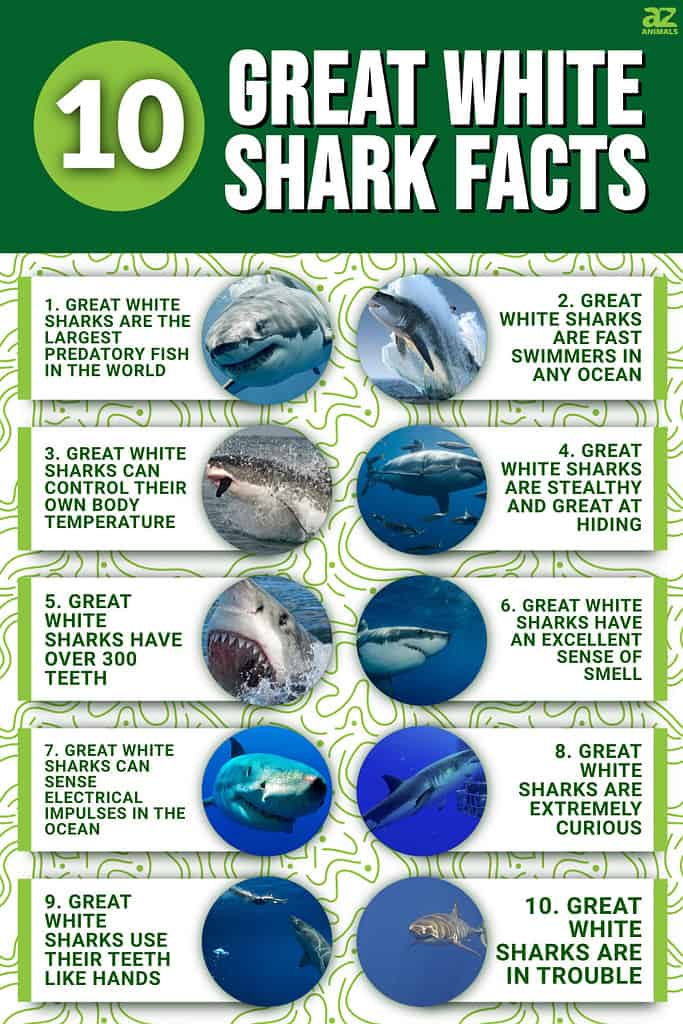
1. Great White Sharks Are the Largest Predatory Fish in the World
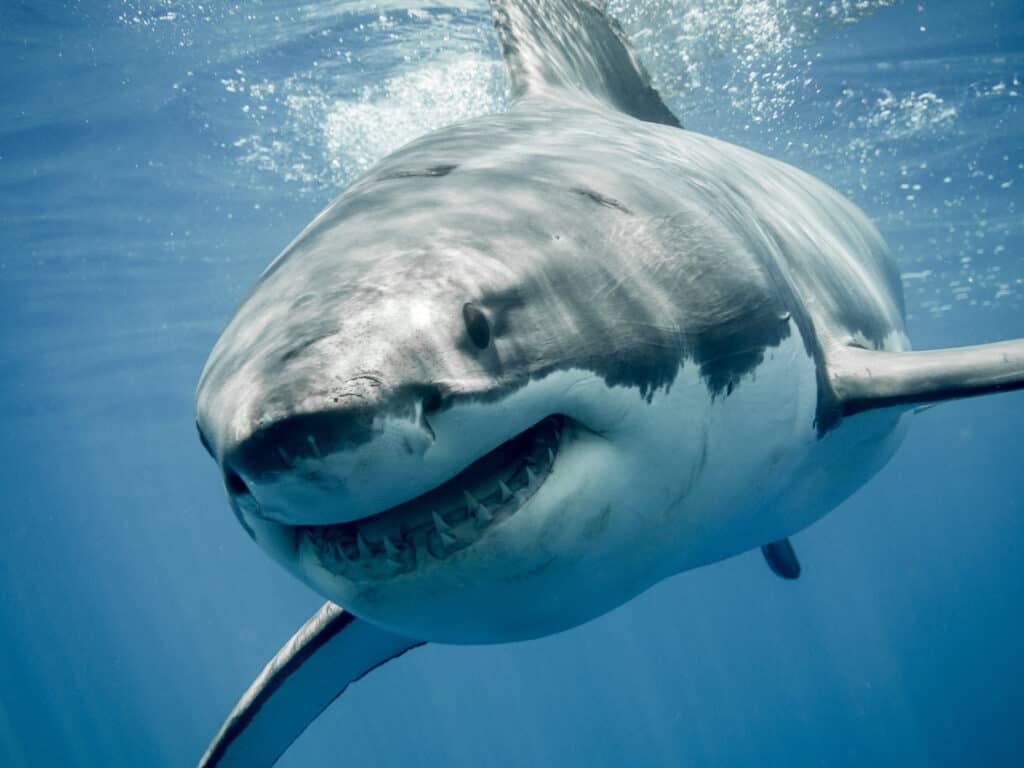
As the largest predatory fish that exists, there are so many incredible facts about great white sharks!
©Ramon Carretero/Shutterstock.com
The great white shark is the largest predatory species of fish, and the largest predatory shark in the world. These massive killers grow 14-18 feet long on average and weigh 5,000 pounds! The largest great white shark recorded, however, measured 21 feet long! Great white sharks are apex predators that sit on top of the ocean’s food chain. The only two species on earth that can contest a great white shark are killer whales and humans.
2. Great White Sharks Are Fast Swimmers in Any Ocean
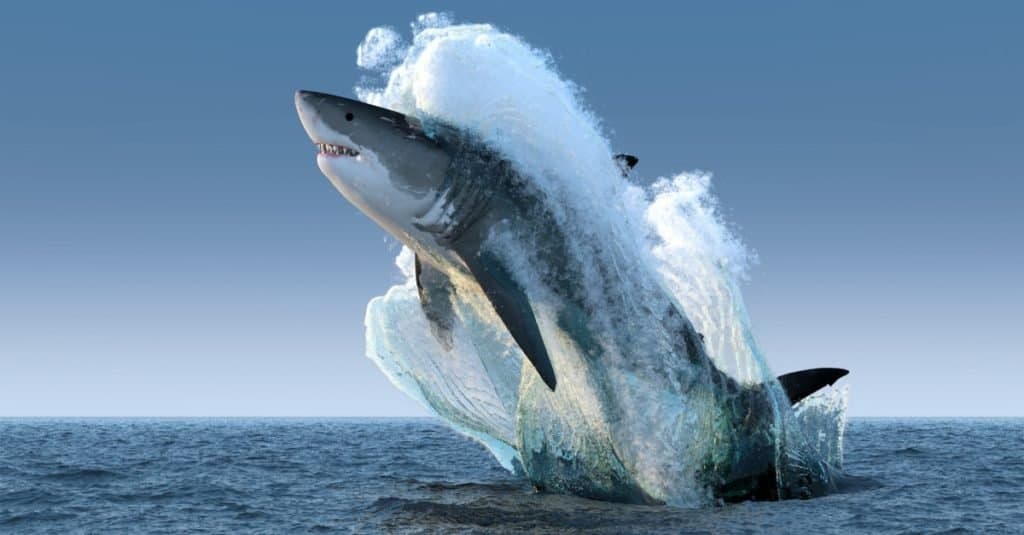
Great white sharks often “breach”, or jump out of the water to snatch prey from above.
©Alexyz3d/Shutterstock.com
These sharks may be massive, but that doesn’t slow them down. In fact, with their large torpedo shaped bodies, great white sharks can swim up to 25 miles an hour and leap out of the ocean nearly 10 feet into the air!
Great white sharks generally live in cool or temperate ocean waters near the coast. They also travel through the open ocean as well. They can be found in nearly every ocean across the earth, other than the polar regions and Antarctica. Large numbers of these sharks often gather in South Africa, New Zealand, Australia, California, the Pacific Coast of Mexico, and along the northeastern coast of the United States.
3. Great White Sharks Can Control Their Own Body Temperature
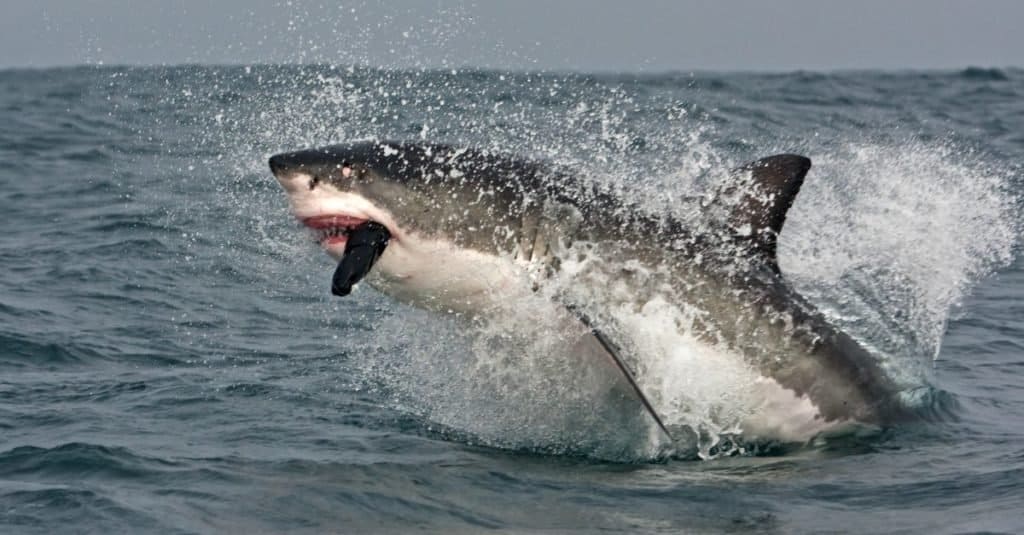
Great white sharks are able to live and hunt in cold oceans due to their ability to regulate their own body temperature.
©Martin Prochazkacz/Shutterstock.com
Fish are dependent on the temperature of the water surrounding them. However, the great white shark has a unique evolutionary advantage. This massive fish has the ability to lower or raise its body temperature on its own! In fact, a great white shark can maintain its body temperature at 55°F higher than the water around it. This is why great white sharks can live and hunt so efficiently in colder oceans. In addition, this also provides great white sharks extra turbo boosts even when they are in cold waters.
4. Great White Sharks Are Stealthy and Great at Hiding
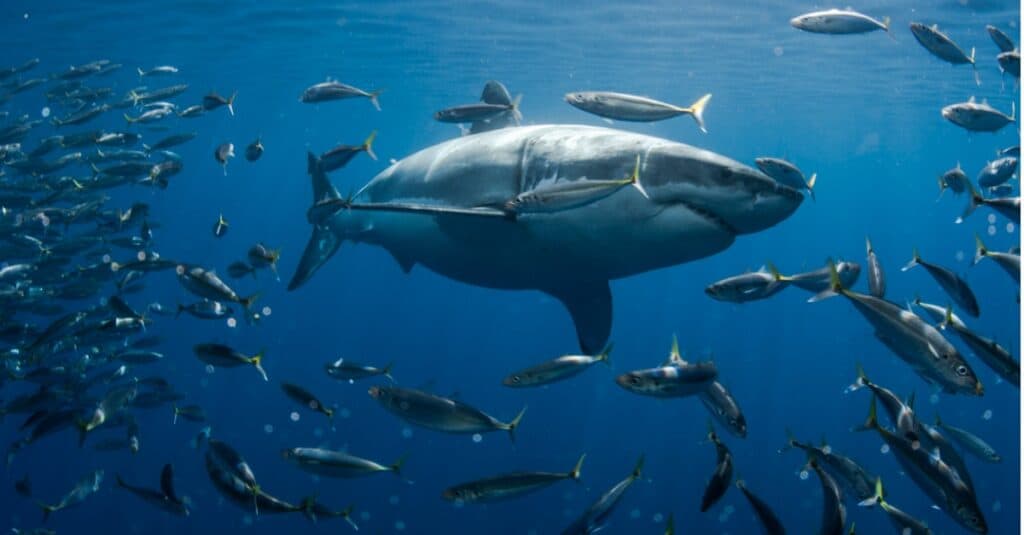
Despite their massive size, great white sharks can effectively hide from their prey until ready for attack.
©iStock.com/atese
It’s hard to believe a 20-foot-long killer fish could really “hide” from its prey, but that is exactly what the great white shark does. Great white sharks often hunt prey that swim along the surface of the water, like sea lions and seals. The top half of their bodies is grey, allowing them to blend in with the rocky sea floor beneath them. This way the seals swimming near the water’s surface cannot see the sharks stalking them from below. The sharks, however, can see the seal perfectly well from their excellent vantage point.
In addition, the bottom half of a great white shark is white and blends in with the sunlight on the surface of the water. This way the shark is hard to see both from above and below and can silently stalk its unsuspecting prey.
New research suggests that great white sharks might even be able to alter their coloring! A group of scientists off the coast of South Africa recently performed a series of experiments with great white sharks and their skin cells. They discovered that each shark’s coloration altered slightly depending on its environment, the time of day, and emotional stimuli.
5. Great White Sharks Have Over 300 Teeth

The teeth of a great white shark have serrated edges, and can be over 2 inches long.
©Martin Prochazkacz/Shutterstock.com
There are more than 300 teeth in a great white shark’s mouth. Each tooth is triangular-shaped with serrated, razor-sharp edges for tearing through flesh. They are about 2 inches long and are arranged in five to seven rows in the shark’s mouth. Sharks continually lose and replace their teeth throughout their long lives. A single shark may go through as many as 20,000 teeth in 70 years! Unlike human teeth, however, great white shark’s do not need to wait long for their new teeth to grow into place. Instead, several rows of replacement teeth already sit in reserve in the sharks’ jawbones, ready to swing forward when needed.
Great white sharks also have unattached jaws that are mobile. The top and bottom jaws can move separately, so when the shark attacks, it can bite with its lower jaw and then its upper jaw. With their unique jaws and rows of killer teeth, sharks can tear off large chunks of meat at a time.
6. Great White Sharks Have an Excellent Sense of Smell
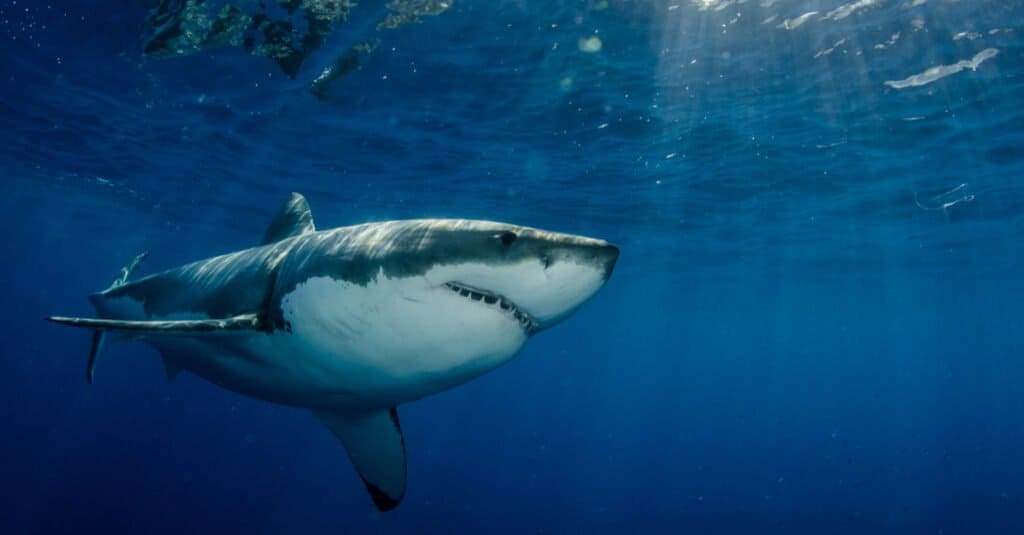
The great white shark has an incredible sense of smell that helps it to detect prey from two miles away.
©Byron K. Dilkes/Shutterstock.com
Yes, a fish really can smell underwater, and the great white shark has transformed this incredible skill into art. Underneath the shark’s snout are its nostrils, which are connected to the olfactory bulb. The olfactory bulb is an organ that allows the shark to detect smells across wide stretches of water. In fact, the great white shark can smell a single tiny drop of blood within 10 billion drops of sea water!
But what happens if you’re at the beach this summer and scrape your leg in the water? Turns out there is no need to worry. Unlike Hollywood films, sharks do not instantly rush to the scene and attack just because they smelled a little bit of blood. Great white sharks are intelligent animals that use a combination of all their fine-tuned senses to analyze their environment, not just their excellent sense of smell.
7. Great White Sharks Can Sense Electrical Impulses in the Ocean
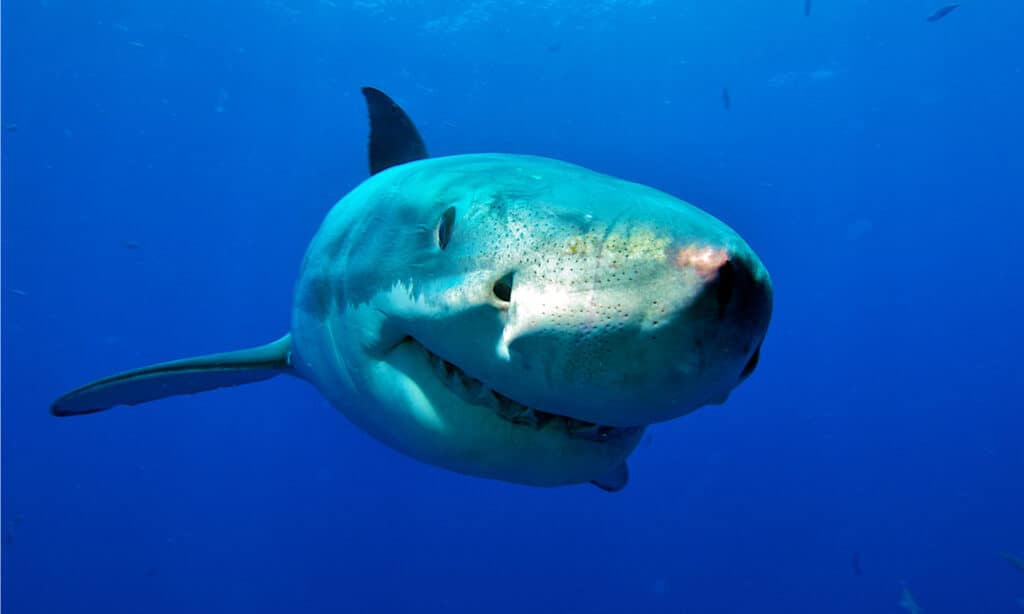
Great White Shark are curious and often investigate new objects in the ocean, like divers in shark cages.
©Stefan Pircher/Shutterstock.com
In addition to their incredible sense of smell, great white sharks also use “electroreception”. This is an extra sense that allows sharks to track electric fields generated by objects and animals in the water. Sharks have unique sensory organs called “Ampullae of Lorenzini” at the end of their snouts that allow them to sense even the faintest electrical impulses in the environment around them. Great white sharks can sense prey from miles away, and even locate animals hiding behind rocks or beneath the sand.
8. Great White Sharks Are Extremely Curious

A huge great white shark investigates 3 divers in a shark cage as sun rays penetrate the clear, cool waters of Guadalupe Island, Mexico.
©J nel/Shutterstock.com
Between their incredible senses of electroreception and smell, it would seem that no one is safe from a great white shark. However, even with the millions of people swimming along beaches each year, there are very few shark attacks. In fact, in the last century there were 108 shark attacks along the United States’ Pacific Coast, but only eight were fatal. With the enormous size, incredible senses, and expert killing power of a great white shark, that number should be much higher—unless of course, great white sharks are intentionally attacking humans.
One of the most common myths about great white sharks is that they have poor eyesight and often mistake humans for seals. The truth is, however, that great white sharks have excellent eyesight! These sharks have very large, dark blue eyes, with retinas that are built for both day and night vision. In fact, great white sharks can see better than humans, even in dim lighting or murky water.
So Why Do Sharks Attack Humans?
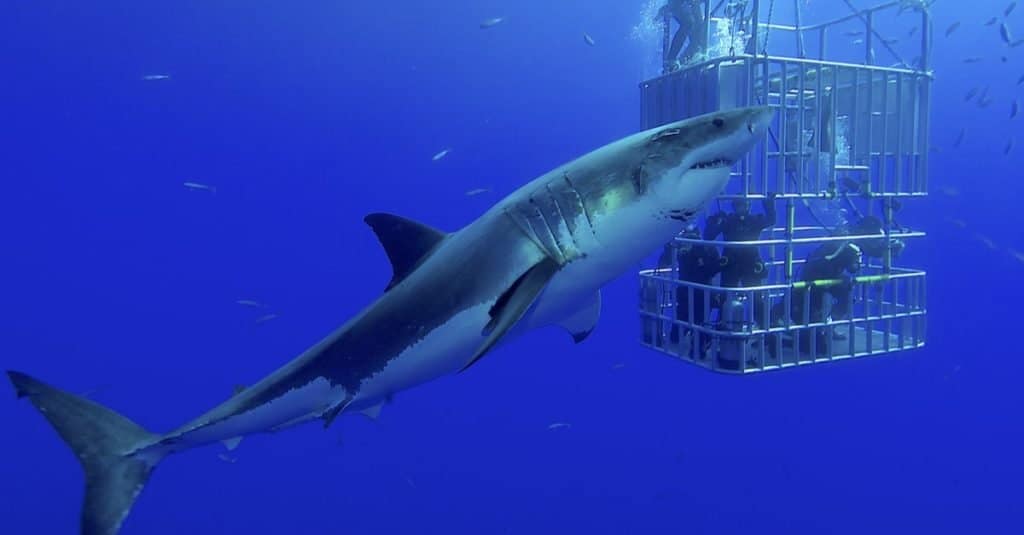
A great white shark swims around a diving cage. The great white shark is one of more than 450 shark species and is the largest of all predatory sharks in the ocean today.
©Stefan Pircher/Shutterstock.com
If it is not a case of mistaken identity, then why do great white sharks attack humans? It turns out that these animals are not the mindless killers that they are often portrayed as. In fact, great white sharks are not only intelligent, but they are extremely curious and spend much of their time investigating the world around them. Simply put, great white sharks do not attack humans out of hunger, but out of curiosity!
As experienced shark researcher R. Aidan Martin explains, shark attacks on humans are very different than when they attack traditional prey animals like seals. When a great white shark attacks a seal, it speeds to the surface of the water and rams it with incredible force as it tears into the animal’s flesh with its razor-sharp teeth. On the other hand, in human attacks, great white sharks swim slowly, at a leisurely pace, without using any of their immense power and force to “attack”. This is because great white sharks are not hunting humans—they are curiously investigating them.
It makes sense, since great white sharks have also been known to take a bite out of many other things that look nothing like a seal, marine animal, or potential food item. These sharks curiously bite into anything from brightly colored surfboards and small boats, to inflatable beach toys and buoys.
9. Great White Sharks Use Their Teeth Like Hands
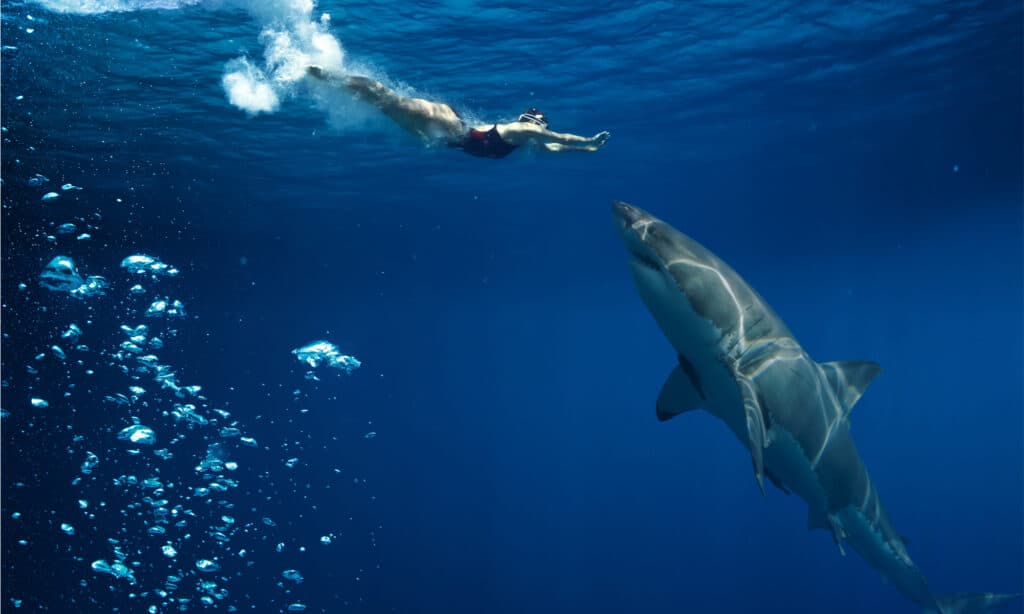
There are many trained professionals today that swim with great white sharks in the ocean, continually learning more and more about these mysterious creatures.
©Willyam Bradberry/Shutterstock.com
But wait a minute, if great white shark attacks on humans are simply due to curiosity and not aggression, why do they use their deadly teeth?
Great white sharks are extremely inquisitive animals that will investigate even the smallest debris floating in the water, simply out of curiosity. However, since they do not have hands, they use their mouths instead. Their unattached jaws are retractable, similar to the claws on a cat. In addition, their teeth are connected to sensitive nerve cells, and have 10-15 degrees of flexibility as well. This allows sharks to grab something, and “feel” it with their mouths to discover what it is, much like humans do with their hands.
The problem with this is that even a small investigative “test” can cause a great deal of damage to soft-bodied animals like humans because of the shark’s 300 razor-sharp teeth. However, even though great white sharks are responsible for the highest number of shark attacks on humans, there are very few human deaths. In fact, you are more likely to be killed by lightning or a dog bite than by a great white shark. That is because when a great white shark “attacks”, it commonly only takes a single bite. When a great white shark bites, it is often just curious and trying to investigate.
10. Great White Sharks Are in Trouble
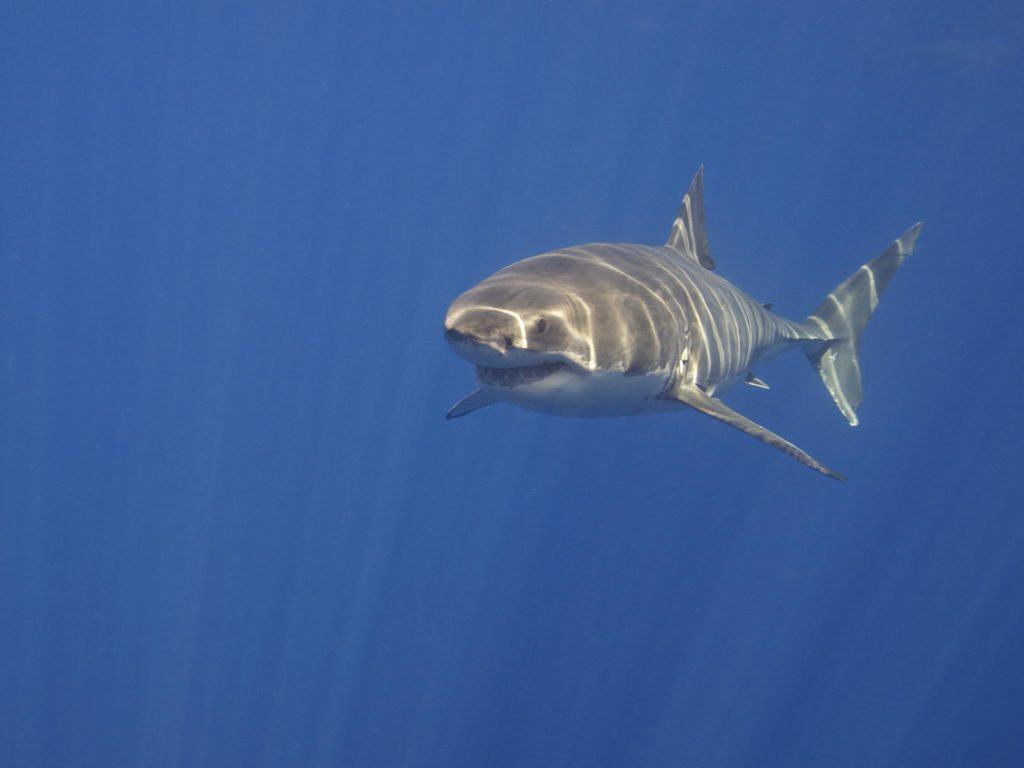
Approximately 6-8 humans are killed each year by sharks. Humans, on the other hand, kill over 100 million sharks every single year.
©Elias Levy / Flickr – Original
With school-bus sized bodies and over 300 deadly sharp teeth, you might expect the great white shark to rule the seas with uncontested power. This is true to some extent, but there are still two other species that can harm and kill great white sharks: orcas and humans. Orcas, or killer whales, have been known to hunt these sharks for their nutrient-rich livers. In recent years this has led to a shocking decrease of great whites in areas where they were once abundant.
The greatest threats to the future of great white sharks, however, are humans. Great white sharks are opportunistic eaters that commonly eat seals, sea lions, rays, fish, and even other sharks. However, these prey animals are declining due to overfishing and climate change. In addition, Great white sharks are often accidentally caught up in commercial fishing nets as they try to hunt these animals. Due to their size and notoriety, great white sharks are also actively hunted by humans as sports fishing trophies, as well as for their teeth and fins.
Great white sharks are now classified as a “vulnerable species” by the IUCN Red List. Fortunately, there are people and organizations devoted to protecting these misunderstood animals and educating the public on their vital place in keeping the oceans’ ecosystems in balance.
The photo featured at the top of this post is © Martin Prochazkacz/Shutterstock.com
Thank you for reading! Have some feedback for us? Contact the AZ Animals editorial team.







